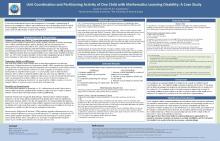Click image to see poster.
Abstract
Purpose: A continued instructional focus on the development of conceptual understanding of fractions as quantities for children with mathematics learning disabilities (MLD) is critical. We investigated “What ways of partitioning and unit coordinating does a fifth grade child with MLD display in equal sharing tasks? “
Perspectives: Current special education interventions employ explicit instruction to deliver knowledge onto children with MLD and measure their 'responsiveness' to instruction (Test & Ellis, 2005). This is beneficial if the goal of instruction is to increase efficiency with demonstrated procedures. Yet, supporting conceptual growth involves children "[solving] problems within reach [while] grappling with key mathematical ideas that are comprehendible but not well formed" (Hiebert & Grouws, 2007, pp. 387). Such a stance benefits this historically marginalized group of children by immersing them in instruction that supports active conceptual growth.
Methods: “Jim” (12 years old) was purposively chosen to participate because his standardized state performance was at a failing level for three years and he evidenced significant difficulties with visual motor integration (2nd percentile). Data collection occurred through clinical interviews (Ginsburg, 1997) and seven sessions held within a teaching experiment (Steffe & Thompson, 2000). Sessions were held during school hours in addition to the child’s regular math class time. A graduate student was a witness (e.g., took extensive field notes, provided an observer’s prospective during on-going analysis). Researchers collected three sources of data: transcribed video recordings, written work, and field notes.
Researchers conducted ongoing analysis before and after each episode to document what conceptions might underlie the child’s apparent activity. Second, after all data were collected and transcribed, we identified indicators of Jim’s conceptual growth through the constant comparison approach (Strauss & Corbin, 1997). We coded Jim’s partitioning and unit coordinating activity by task, examining transcriptions line by line for confirming and disconfirming evidence. We compared each set of codes generated for each task with previously coded data to ensure consistency and created an initial codebook. Codes were then compared using peer debriefing and collaborative work. Finally, researchers used the amended codebook to code all remaining tasks in the remaining sessions.
Results: Analysis showed four distinct ways of partitioning [Midpoint partitioning; Midpoint partitioning w/composite (symmetry); Composite partitioning with unequal parts; and Composite partitioning with equal parts] and three ways of unit coordination [Number of parts unrelated to number of sharers or to the whole; Number of parts related to sharers but not the whole; Number of parts related to sharers and the whole]. Variances in partitioning and unit coordinating will be presented in depth in the full paper.
Significance: Jim evidenced a sustained attention to midpoints as a basis for partitioning and coordinating units. The midpoint partition seemed to destroy Jim’s notion of the whole as the distance between two endpoints (as opposed the distance from an endpoint to the midpoint). Yet, sustained work in the tasks seemed to support Jim to begin to coordinate partitioning and created units with the whole in terms of the length as the distance from endpoint to endpoint.
